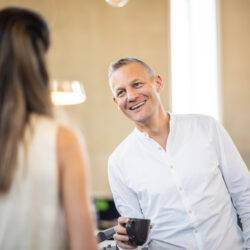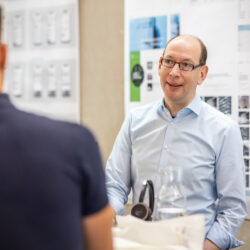We build the future
Even if we have to make assumptions about many things and take some risks, it is our duty to shape today’s building activity to the best of our knowledge and belief and in a mindful and forward-thinking manner.

We build the future
The aspiration in the building sector must be to construct infrastructure and buildings based on the efficient use of resources and offer high value for future generations. This is the case if the structures can be used with the resources and financial means available in the future in terms of the social needs that will prevail at that time. As this is difficult to predict, it is vital that they are capable of being easily re-purposed or even dismantled into their individual parts and rebuilt.
How do I build sustainably? How do I build for the future? Giving a general answer to these questions is not as easy as it might seem at first – perhaps even impossible. We have learned over the years. The example of asbestos is a good illustration: everyone agrees that this type of silicate mineral must no longer be used. There is a substantial list of insights of this kind that have made our buildings more sustainable.
In addition, we have realised that we are quickly confronted with conflicting objectives when observing individual “sustainability requirements”. For example, we can cut the investment budget by choosing a “cheaper” building material that also requires less grey energy in production, but this option is not very durable. Or we make a higher investment, consume more grey energy in production, but end up with a very durable and low-maintenance construction. Which is the right choice?
Ultimately, it emerges that there can be no universally valid definition of sustainable building. Nevertheless, there is now a more or less clearly defined framework that is the subject of ongoing further development. It is imperative to respect this. Within this framework, we have to find the right compromise, depending on the situation and the project.
There are sustainability standards, labels and certifications on the market for this purpose, such as SNBS, DGNB or LEED, which cover a clearly defined area. Ultimately, they specify certain conditions for compromise based on a rating system and rating levels (silver, gold or platinum).
Furthermore, it is crucial for us as professionals to remain curious, alert and critical so as to find the best solution in every situation. In some cases, it can also be right not to apply a standard, but to pursue new and innovative paths instead. We often make progress through trying out new things, and quite often it is worthwhile taking a look back at the past. Many things were known to the generations before us, or were intuitively done correctly.
We’re aware that we don’t yet know everything that will prove to be true in the future. This is something that history has taught us. Nevertheless, we must convincingly summon the courage to take the next step based on what we do know now. And equally, we must have the courage to correct our actions as soon as we arrive at new insights. We mustn’t let our pride get in the way. Humility and openness in this connection promote the necessary mindfulness.
We are committed to the task of sustainable construction, the approach described here and these values. In terms of sustainability, we are able to support you with certifications and advice on building projects without a label. In us, you also have a partner who has the courage to join you in exploring new things. Sustainability shapes our thoughts and actions as well as our corporate culture.
Our team is defined and distinguished by its diverse range of talent, knowledge, ideas, approaches and perspectives – under the common motto: Shaping the future.

Stefan Berner im Gespräch mit Mitarbeitenden zu nachhaltigem Bauen.
Lisa Haller
Our mission in planning and consulting is to pick up on specific requirements and integrate them into the project in the best possible way, the idea being to ensure a high level of comfort and convenience for users over the long term. Sustainable construction, as part of overall sustainable development, goes one step further and calls for the meeting of present needs without putting those of future generations at risk. The onus is therefore on the construction industry to develop efficient, consistent and, above all, appropriate solutions that enable future generations to enjoy an equivalent standard of living in terms of resource consumption, comfort and convenience. By deploying future-oriented and sustainable construction practices, a small contribution can be made in solidarity with – and for – today’s generations and those of the future. This is what motivates me every day anew.
Patrick Hertig
One thing that motivates me when it comes to building for the future is its long-term nature. We have to plan and construct buildings in such a way that they also benefit our children and their children. I know of no other material issue where the long-term aspect is so important. Be it flexibility of use, expandability or deconstructibility, we have to think about all these issues now, so that today’s buildings do not become a burden for future generations in the distant future. I am also fascinated by the huge stock of buildings from a wide variety of eras. The pool of existing buildings resembles a sandpit that is waiting to be explored. I am driven by the opportunity to find solutions for upgrading old buildings. Existing resources should be reused and upgraded wherever possible. The use of wood plays a key role here, as the material is light and malleable. Even after many years, wood can be recycled or even reused with comparably little effort.
Clemens Kuhn-Rahloff
The creation of acoustic spaces. How we perceive a room depends on the materials, the proportions, the light – and, of course, the acoustics. We perceive the visual impressions as soon as we enter the room. The acoustics convey the underlying impressions; they integrate us into the environment, create communication and relativity, and convey quality. Ultimately, design issues underpin all the technical aspects of building acoustics.
Lisa Haller
Ultimately, when it comes to construction, the focus is always on people. So it is important to remember that we plan and build for people. The needs of current and future generations should be considered in a focused manner and met in the long term. In order to speak of sustainable construction, an integral and all-encompassing consideration of the three dimensions of sustainability is necessary. We will only be able to speak of a sustainable building when society, the economy and the environment are integrated equally and as comprehensively as possible into its planning and construction.
Patrick Hertig
At Gartenmann Engineering AG, I mainly deal with energy-related issues. When it comes to energy efficiency in buildings, I always try to keep an eye on the package as a whole. A well-insulated building envelope alone is only a small part of the big picture. Energy-efficiency can only be achieved when the envelope, the technology and the users interact at an optimal level. If, on top of that, you ensure that the construction is carried out with as little energy as possible and that the end-of-life disposal does not require enormous amounts of energy, then you can talk about energy efficiency over the entire lifespan of a building.
Clemens Kuhn-Rahloff
In addition to the ecological and economic aspects of sustainability, people are a key component. We create buildings for people, and the quality standard for what we realise is human perception. For example, almost all target and guideline values in acoustics are ultimately based on scientific studies or empirical values – those that humans use to judge acoustics. When it comes to sustainability, this perspective is a common thread of planning.
Lisa Haller
With regard to climate policy, the focus of construction currently lies mainly on energy strategies and the energy efficiency of buildings – with the associated subsidies. Instead, incentives should be created that promote a holistic approach to sustainability. In addition to government subsidies for energy efficiency, issues such as resource conservation and the circular economy must be integrated into future planning. This requires the creation of a state framework. Only when such incentive systems exist will “sustainable construction” become a reality.
Patrick Hertig
For the future of construction, I hope there will be increasing numbers of investors and architects willing to experiment with sustainable construction. For me, resource conservation, energy efficiency and recyclability are as important as the building’s functionality and aesthetics. There should be more use of wood. Technology should not be used less or more, but should be used to generate added value. Efficiency should be incorporated into the building’s planning phase and monitored for many years once it is up and running. I could go on like this forever, but in the end I wish for one thing above all: a building should be carefully thought out and erected where it is really needed, not where the focus is on investments and returns. Refurbishment and densification should come first. This is definitely more intelligent than building on a greenfield site.
Clemens Kuhn-Rahloff
Buildings that we are planning today will last for many decades. The judgement of future generations will determine whether we have built sustainably in terms of the environment and value. With this in mind, I would like to see planning with a vision of enduring values, or flexible solutions that keep this time horizon in mind. If we use today’s technologies correctly, the digitisation and automation of planning and execution processes will help us achieve this. That’s because we can then test future scenarios for buildings as early as the planning phase, the optimisation of which would have been far too time-consuming with previous planning methods.


Site Bern
T +41 44 545 15 35
E c.kuhn-rahloff@gae.ch
To the profile

